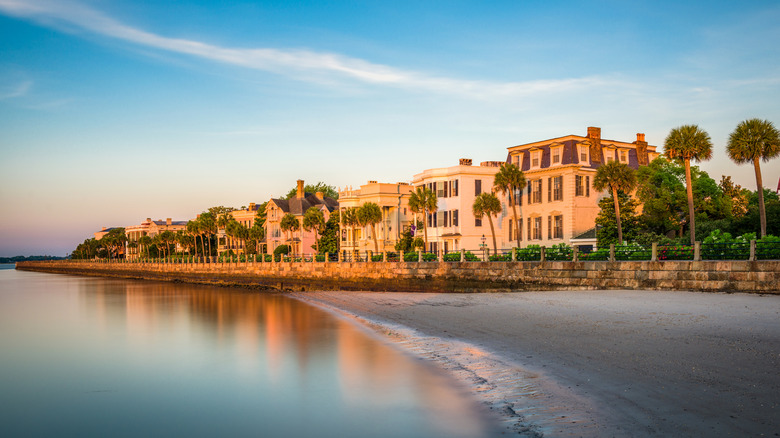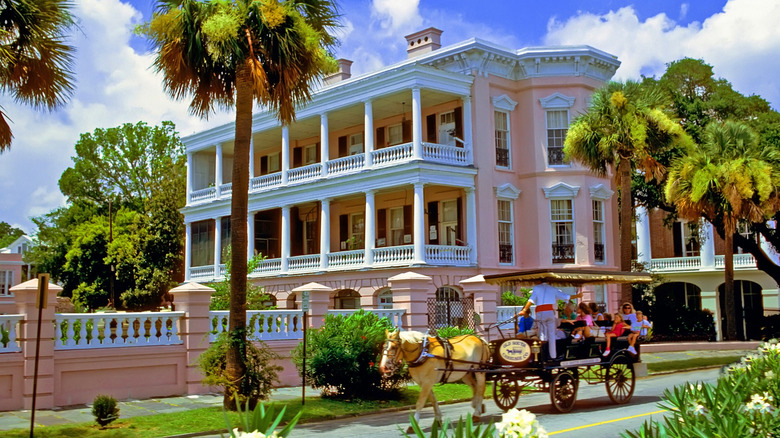Charleston's Romantic Waterfront Promenade Is Lined With Southern Mansions And Sweet Harbor Breezes
As far as romantic cities go, Charleston stands out as one of the South's most charming. With moss-draped oak trees, a fresh sea breeze to cut through the humidity, and antebellum architecture that lends to Charleston's striking European appearance, it's the ideal setting for an intimate vacation — especially around the city's iconic Battery.
The Battery forms one of Charleston's most picturesque walks. Linking the Historic Charleston Foundation at 40 East Bay Street with White Point Garden at Murray Boulevard, this stretch, known as the High Battery, boasts some of the city's most historic and expensive real estate. For reference, in 2025, the Charleston Regional Business Journal and The Cassina Group recorded the sale of the nearby John Ravenel House at $18.25 million. The Low Battery refers to the 0.9-mile stretch along the length of Murray Boulevard, perpendicular to the High Battery. The homes here emanate old money and family history, with some estates still held by the original families. With uninterrupted harbor views and relaxing sea breezes, it's easy to see why this is one of the most elite neighborhoods in the country.
Despite its present-day beauty, the city harbors a somber past, serving as a hub during the transatlantic slave trade. Between the 16th and mid-19th centuries, close to half of the enslaved people who arrived in America passed through Charleston. Founded in 1680 as Charles Town, the city's growth and prosperity were closely tied to the exploitation of slave labor. The grand antebellum mansions that line the streets of the Battery today were built on the foundations of slavery. Given its complex and often haunting past, it's no wonder Charleston is home to some of the spookiest ghost tours in America.
The Charleston Battery is the most romantic promenade in the city
With stately houses and oak-lined boulevards, Charleston has no shortage of gorgeous locations. One of the most romantic is the Battery, a fortified sea wall that was built to protect the city from storms and enemies. The original wall was built in the 1720s, before it was fully militarized for the Revolutionary War in 1776. Since then, it has been destroyed, rebuilt, and reshaped by numerous hurricanes. The promenade that exists today was completed in 1854 and has remained the center of this historic city.
The best spot to start your walk is at Waterfront Park, a famous garden home to the iconic Pineapple Fountain, which was built to symbolize the city's wealth and prestige in a time when the fruit was an exotic luxury. From the park, you can catch a glimpse of one of America's longest cable-stay bridges before walking south along East Bay Street towards East Battery Street. Along the 0.8-mile walk through the High Battery, you'll stumble upon the iconic Rainbow Row, a line of 13 brightly painted houses originally built in the mid-1700s.
When walking south through the High Battery, you'll eventually, end up at White Point Garden, a public park memorializing those lost during the Civil War. The DASH Trolley Green Line offers an easy route to the Battery from the city center (roughly 1 mile away), with stops just blocks from the promenade. The other option is to drive and park in one of the spaces at East Bay/Prioleau Car Park, located at 25 Prioleau Street.
Charleston's Battery is lined with historic Southern mansions
The houses along the Charleston Battery, mostly built between the 18th and 19th centuries, are an idyllic example of Southern elegance. Typically owned by plantation proprietors and wealthy merchants, these stately homes were protectively passed down from one generation to the next as a symbol of family legacy.
The homes lining the High Battery mostly showcase grand antebellum architecture, with symmetrical columned facades, high ceilings, and large shuttered windows. However, the newer residences along the Low Battery reflect more Colonial Revival and Neoclassical styles popular in the early 20th century. These homes favor simpler geometric forms and clean lines, compared with the intricate details of the antebellum era. The architectural evolution from one street to the next is a bit like a visual timeline showing Charleston's layered history.
Charleston's sweltering summers played a role in inspiring a new orientation for many homes. Called the Charleston Single House, these homes were designed to face perpendicular to the street to encourage a cross breeze. The houses were designed with shaded verandas positioned behind the back of neighboring houses (or, in some cases, a garden) to shield them from the sun and offer more privacy. Edmondston-Alston House, located at 21 East Battery Street, is one of the most authentically Charlestonian homes on the strip. It was built around 1825 following a Federal and Greek Revival architectural style. The home is open for tours on Mondays from 1 p.m. to 4 p.m. and between Tuesdays and Saturdays from 10 a.m. to 4 p.m. For a $15 entrance fee (as of this writing), you can walk the historic halls and admire the family's antique furniture and silver collections.


